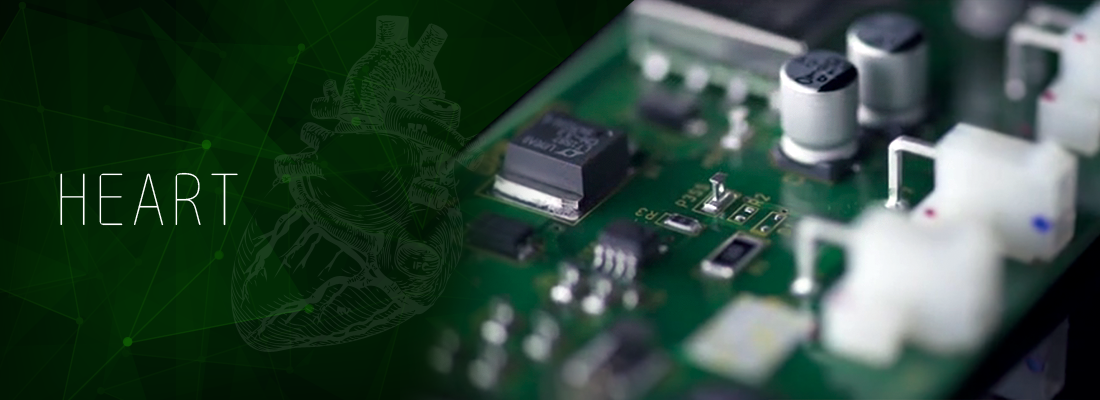Core Technology 01 Electrical Discharge Power Unit

Electrical Discharge Power Supply Unit: the "heart"of Sodick's electrical discharge related products
Generally, high speed processing proceeds with pulse current generated in a stable condition with the pulse control controlling the current and being repeatedly generated through the power circuit, sending a 1000A current within 1 microsecond.
With the finishing, pulse current is repeatedly generated in a stable condition by nano level pulse control. As for the Die-sinker EDMs, stable pulse is generated by a pulse control system by controlling the pulse width and current value to optimum value in order to perform non-wearable electrode machining so that it does not reduce the electrode. These are collectively called an electrical discharge power supply and are the heart of the driving force for high performance (Travelling of only about 30cm is expected even in one nanosecond of light travel).
About Electrical Discharge Power Unit
The history of Sodick’s development all started with the electrical discharge power supply unit, the heart of an electrical discharge machine. Electrical discharge machining is performed by generating discharge in following way. While voltage is applied to two electrodes (electrodes for processing and the workpiece to be processed) with insulating liquid between the electrodes, the distance between the two electrodes is gradually reduced. This electrical discharge energy works as the element to melt and vaporize the workpiece. At the same time, high pressure generated by electrical discharge blows the workpiece material away from the discharge generation part. By repeating these phenomena tens of thousands or hundreds of thousands of times per second, electrical discharge machining progresses.
Features
By controlling the supply method, supply time of discharged energy and the distance between the electrodes, it is possible to control electrical discharge pulses to obtain the desired electrical discharge processing performance.
Wire-cut discharge machining
Thanks to Smart Pulse electrical discharge control technology applied in the latest devices, both high speed processing and high precision processing demonstrating overwhelming performance have been achieved.
- TM circuit: high peak current of 1000A or higher is generated within 1 microsecond without variation
- Barrel-free effect control: significantly improves straight accuracy in 1st processing
- TMP control: improved surface roughness, amount of barrel effect, and corner area shape accuracy in 2nd processing
- Digital-PIKA-W circuit: finishing circuit using ultra-high frequency digital pulse
Die-sinking electrical discharge machining
- SVC circuit: generates one to approximately several ampere currents within one microsecond to several microseconds repeatedly to allow high quality.
- Non-wearable electrode circuit: generates a relatively longer current pulse of tens of microseconds to several milliseconds repeatedly without variation.
- PIKA-circuit: achieves a mirror polishing
- Arc-less PLUS: the electrical discharge stabilized processing system to prevent abnormal arc discharge and achieves high speed processing
Common
Using K-SMC, which performs calculation in units of 10 nanometers, machining gap distance control is performed to 0.1 micrometers (high response linear motor servo control circuit).
Background of Development
Between 1955 and 1965, the electrical discharge method was primarily used in so-called through hole processing since consumable processing with which both the electrode and workpiece are consumed by electrical discharge energy was the mainstream approach. After that, non-wearable electrical discharge circuits were developed as transistor technology advanced. This made it possible to perform bottom bending processing in electrical discharge machining and now it is an essential machine in current mold manufacturing environments. In electrical discharge machining, important development items to improve performance are always how to supply discharge energy efficiently to the machining gap, how to maintain the optimum distance between machining gaps, and how to generate normal electrical discharge constantly. Therefore, to push the limit of electrical discharge machining, we always need continuous improvement in electrical discharge power supply units in line with progress in electronics parts and control technology.
Applied Fields / Related References
The technology is applied for Sodick products which require high energy, such as die-sinker EDMs, wire-cut EDMs, small-hole-drilling machines, power units for electromechanical machining and electron beam PIKA Finish EBM machine, etc.
Related Content
Sodick News Letter: Electrical discharge machining technology
Sodick News Letter: Principles of Electrical Discharge Machining and Non-Wearable Electrode Circuits
